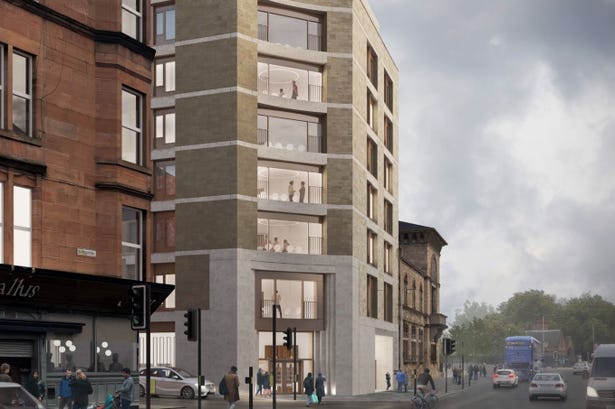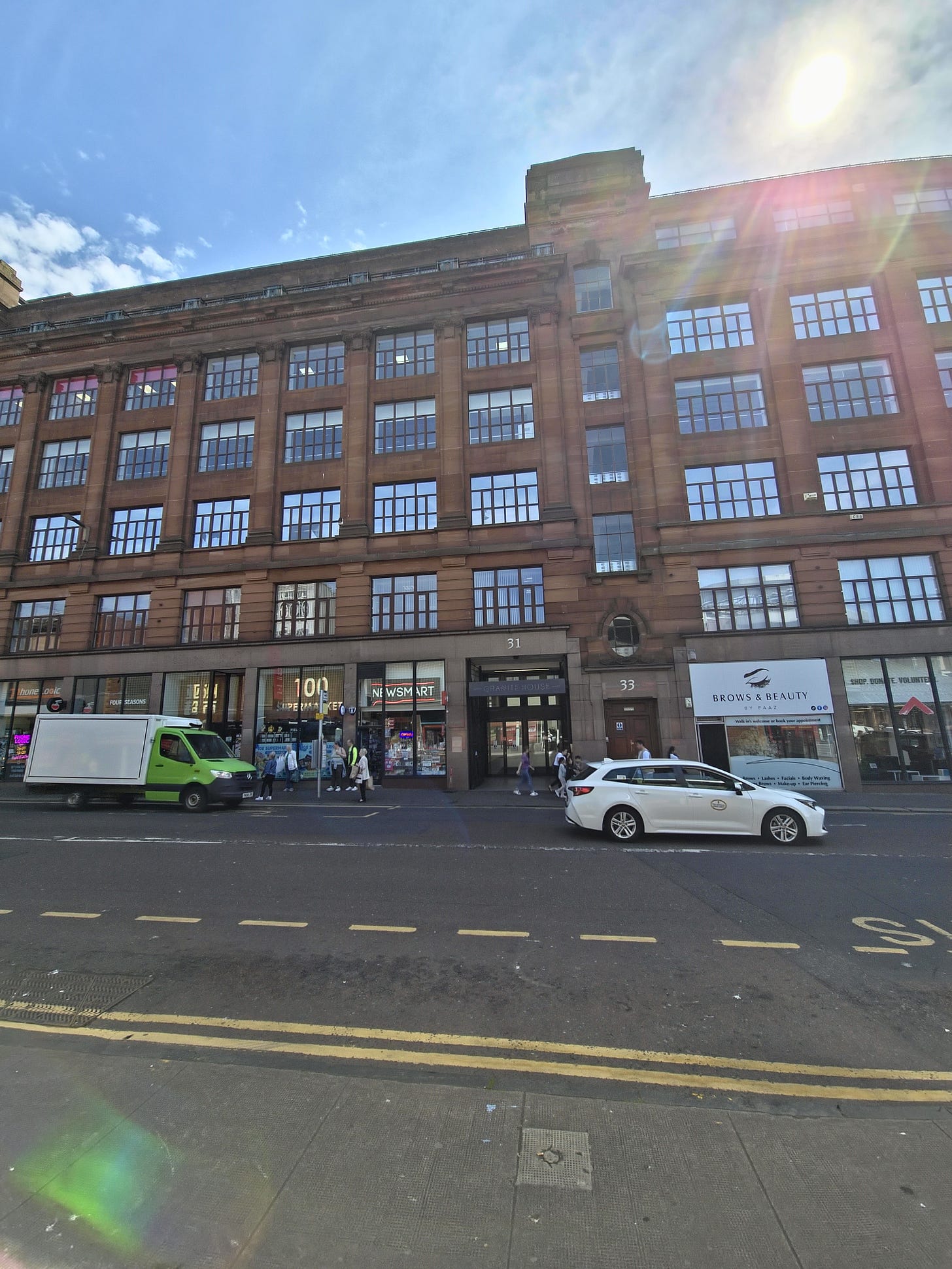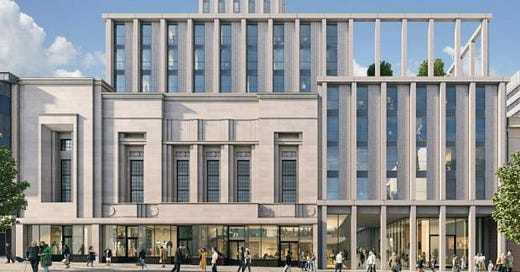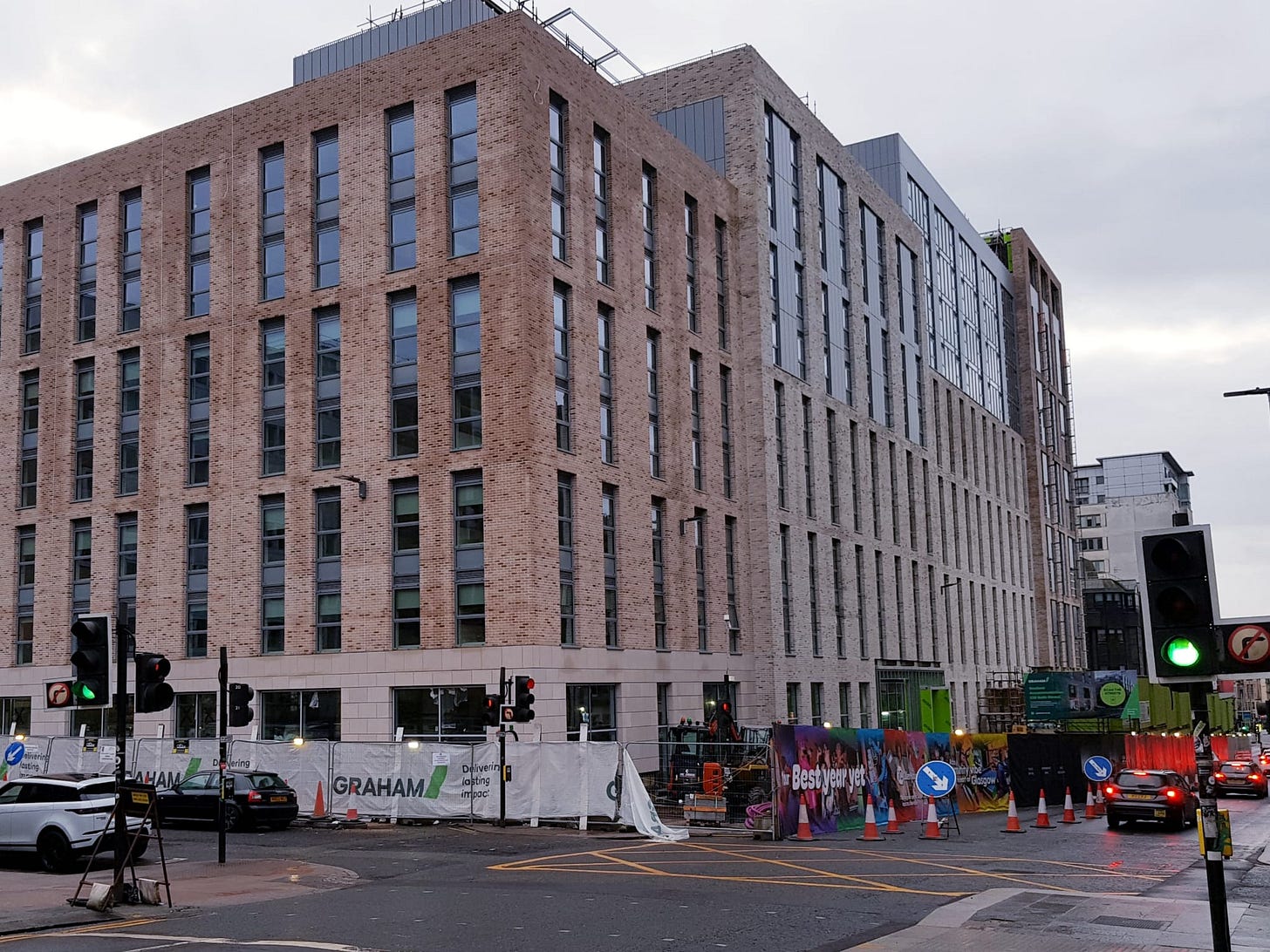EXCLUSIVE: The Sunday Splash Investigation - Glasgow City Council Approves Almost 6000 Student Beds, But Social Housing Lags Behind
Local Authority Approves EIGHT Times More Student Beds Than Social Housing
EXCLUSIVE by Gary Fanning
Glasgow’s skyline is changing—rising higher with sleek, glass-fronted student accommodations, while thousands of local residents struggle to find a permanent home.
Data obtained by The Splash through a Freedom of Information request reveals a stark reality: since 2022, the city council has approved nearly 6,000 new student accommodation beds, but only a fraction of that number in social housing.
This trend has surged in recent years.
In 2024 alone, 4,591 student beds were approved across 12 sites—more than five times the number approved the previous year. In contrast, 2023 saw only 834 beds approved across two sites, and 2022 saw approval for just one site, offering 550 beds.
A report co-authored by the University of Glasgow and published last autumn found that the city faces a student housing shortfall of 6,093 beds. It stated that Glasgow currently has 20,049 beds in purpose-built student accommodation (PBSA).
In August, The Splash revealed that 10,238 student beds were pending approval, with a further 6,229 approved in the last three years. Since 2014, the council has approved 90 student accommodation applications, although some may be duplicates.
Currently, Glasgow hosts over 20,500 PBSA beds, mainly in the city centre and west end. The total student bed count rises to 36,565 (including pending and approved developments), highlighting both growth and ongoing demand.
These figures do not include new PBSA applications submitted since August 2024.
The city’s growing appeal as a university hub has driven this trend. However, critics argue that this focus comes at the expense of affordable housing for local residents.

Social Housing Shortfall
In stark contrast, only 734 social rent units were approved across 24 sites during the same period. Even when including other affordable housing options—such as mid-market rent and shared equity schemes—the total rises to just 1,252 homes.
A yearly breakdown underscores the disparity:
2022: 294 social rent units across 11 sites.
2023: 176 units across six sites.
2024: 264 units across seven sites.
Residents React
Local housing advocates have voiced frustration, calling for urgent investment in social housing.
One resident said: “Thousands of people in Glasgow are without a permanent home, yet we’re seeing far more focus on catering to students. We’re not saying students don’t need places to live, but the council has a responsibility to its residents first. These numbers suggest they’re failing to meet that responsibility.”
Another said: “We are seeing the slow erosion of Glasgow’s heritage.”
📢 [PAID SUBSCRIBER EXCLUSIVE] 📢
Glasgow City Council’s Response: Are They Balancing PBSA and Social Housing?
➡️ What the council says about prioritisation
➡️ The 10 solutions to fix the crisis
➡️ How this issue impacts Glasgow’s long-term future
🔒 Unlock the rest of this investigation by becoming a paid subscriber today. Your support keeps independent journalism alive.
[Subscribe here] – Make a difference today.
[Subscribe now to continue reading →]
One resident asked: “Has the council researched whether student flats free up HMOs (houses in multiple occupation) for families? Landlords can make £2,000 per month from student lets. Why would they switch to private renting with rent caps and higher taxes? There is no incentive for landlords to give up their HMO licences and stop renting to students.”
Councillor Angus Millar admitted that data is lacking and added: “We need figures on how many HMOs are converting back into family homes. In theory, purpose-built student accommodation should ease pressure on the private market. I will ask the question.”

Scottish Conservative Glasgow Region MSP Annie Wells said: “Glasgow has a proud history as a university city, and while student housing needs must be met, the right balance must be struck.
“Savage and sustained SNP cuts mean the city is facing a housing emergency, and thousands of vulnerable people are paying the price.
“Despite being cash-strapped, the council needs to ensure that its housing priorities focus on delivering the homes people urgently need across our communities. Otherwise, we will continue to see the numbers of those without a permanent roof over their heads spiral out of control.”
Representatives from seven community councils convened last year to address the demographic shift and lack of social housing.
Concerns include the dominance of student developments in prime city areas like Trongate and Sauchiehall Street. Notably, about 2,000 new student beds across six developments are planned within a 400-metre area of Trongate alone.

Residents are not opposed to student accommodation but believe new developments should be more evenly distributed across the city.
Merchant City and Trongate Community Council is urgently requesting an immediate moratorium on purpose-built student accommodation in its area, following measures imposed by Glasgow City Council in Yorkhill and Townhead/Port Dundas due to concerns of over-concentration and the potential harm to residential amenity.
Concerns also extend to financial implications, as the average student accommodation cost in Glasgow is £14,000 per year, with some paying up to £1,500 per month for a small studio. Critics argue this is unaffordable for many families.
Research by NUS Scotland reveals that 12 per cent of students have experienced homelessness, with the rate rising to 21 per cent among international students.
The student union is calling for comprehensive housing reforms to tackle the crisis.
Sai Shraddha S. Viswanathan, NUS Scotland President, said: “We desperately need action to address the housing emergency, but simply building more purpose-built student accommodation in isolation will not work, especially as the sector remains poorly regulated, and the housing it produces is often prohibitively expensive and of poor quality.”
Alison Watson, Shelter Scotland Director, said: “The only solution is social housing. Glasgow needs more social homes, and it needs them now.”
Council's Response: Balancing PBSA and Social Housing
Glasgow City Council maintains it does not prioritise student accommodation, arguing that PBSA developments are private-sector led while social housing depends on Scottish Government funding.
Council’s Approach to PBSA
The council states that student accommodation is driven by private developers and follows market demand, with the city council not directly controlling or leading PBSA development.
Social Housing Investment Plan
The council’s Strategic Housing Investment Plan (SHIP) aims to deliver 6,637 affordable homes over the next five years, subject to funding availability. However, critics argue this is insufficient given the growing demand for social housing.
Economic Benefits of PBSA
While the council acknowledges that PBSA developments do not generate council tax revenue, they argue that these developments contribute to the city’s wider economy.
A council spokesperson added that while social housing construction is steady but slower, PBSA applications tend to come in waves driven by global investment trends, not by local needs.
What’s Next?
With more than 8,000 people in temporary accommodation, many argue that the focus should shift towards meeting the urgent need for social housing. Critics say that without intervention, the city risks exacerbating inequality and homelessness.
If left unchecked, this trend risks deepening the divide between the city’s transient student population and its long-term residents, further exacerbating homelessness and inequality.
As Glasgow continues to expand as a destination for education and industry, striking the right balance between housing for transient populations and long-term residents will remain a challenge. Campaigners are urging the council to prioritise social housing in future planning decisions, with calls for greater transparency and accountability in addressing the housing crisis.
For now, however, the numbers paint a clear picture: while thousands of new beds await the city’s students, thousands of residents remain without a place to call home.
Top 10 Solutions to Tackle Glasgow’s Housing Crisis: Balancing Student and Social Housing Needs
1. Implement a Moratorium on Student Accommodation in Over-Concentrated Areas
As highlighted by the Merchant City and Trongate Community Council, a temporary moratorium on new PBSA developments in areas already saturated could help address over-concentration in prime city spaces. This measure would give the community time to reassess the balance of housing needs and allow for better integration of student accommodation across the city.
Action: Pressure Glasgow City Council to adopt moratoriums in specific areas, as seen in Yorkhill and Townhead/Port Dundas, to prevent an overwhelming student housing presence in already impacted neighbourhoods.
2. Encourage a Mix of Housing Types in New Developments
Developments should include a mix of purpose-built student accommodation (PBSA) alongside affordable housing options, particularly social housing. Ensuring that developers allocate a portion of their projects to affordable units could help address the growing need for both student and social housing in a balanced way.
Action: Advocate for changes to planning regulations that require mixed-use developments, with a mandatory percentage of affordable homes included in all new PBSA projects. This would encourage developers to meet both student housing and community needs.
3. Increase the Speed of Social Housing Development
Streamlining the approval and construction process for social housing, possibly through fast-tracked planning for affordable housing projects, could help alleviate the shortage. The Strategic Housing Investment Plan (SHIP) aims to deliver thousands of affordable homes, but accelerating this process is crucial in addressing the immediate needs of the community.
Action: Push for policy changes that provide better funding for social housing and aim to shorten the time it takes for new projects to be built. The Council should prioritise shovel-ready projects and explore creative solutions like modular or prefabricated homes.
4. Invest in Regulating the Student Accommodation Market
The student accommodation market is largely unregulated, which contributes to high rent prices. Introducing regulation around pricing and quality standards for PBSA would help ensure that these developments meet the needs of students without becoming a source of exclusion for lower-income renters.
Action: Advocate for legislation that caps rent prices for PBSA and introduces stronger quality checks. This could help prevent the high costs currently associated with student housing and make it more accessible to a broader range of students, particularly those from disadvantaged backgrounds.
5. Reassess the Impact of HMOs (Houses in Multiple Occupation)
There should be more transparency and oversight of the impact of HMOs on local communities. Research could be done to determine how much student housing in the form of HMOs frees up housing for families. This could help decide whether policies should encourage conversions of HMOs back into family homes, especially in areas that already have a heavy concentration of student housing.
Action: Initiate a review of HMO licenses and their role in providing housing for families. This could involve offering incentives for landlords to convert student flats back into family homes, addressing both the student housing shortage and the need for family housing.
6. Engage with the Community for Feedback and Solutions
There is a need for more community engagement around housing development. Local residents are most familiar with the impact of developments in their area and can provide valuable insights into the solutions that would work best for them. Hosting regular public forums and consultations would allow the council to hear from residents and incorporate their input into future planning decisions.
Action: Organise town halls or public consultations where residents, local housing advocates, and students can discuss their concerns and propose solutions. This participatory approach would ensure that the needs of both local residents and students are balanced.
7. Explore Innovative Housing Models
Look into alternative housing models like cooperative housing or community land trusts, which could offer long-term solutions to the affordability crisis. These models empower communities and can be more adaptable to changing needs.
Action: Investigate and pilot community-led housing initiatives, such as land trusts or co-ops, which allow residents to have greater control over development and pricing, ensuring homes are affordable and sustainably managed.
8. Push for Enhanced Collaboration Between Government and Developers
A collaborative approach between the Scottish Government, Glasgow City Council, and developers is essential for addressing the city’s housing needs. Incentivising developers to work with the local authorities to meet both student and social housing demands could be key in solving this issue.
Action: Advocate for the creation of an inter-agency task force, including the city council, Scottish Government, and private developers, to come up with joint solutions that balance student housing and affordable housing.
9. Support the Expansion of Affordable Housing Programs
The city needs more funding and support for affordable housing projects. There should be a focus on increasing the number of available homes for vulnerable residents and low-income families. Campaigning for more direct government investment into affordable housing programs can address this gap.
Action: Campaign for increased funding to affordable housing programs and for more governmental support to fast-track the construction of affordable homes, particularly for those in urgent need of accommodation.
10. Implement Rent Control Measures for Students
Given the rising costs of student accommodation, rent controls or rent subsidies for students could be a solution to ensure that housing remains affordable for a diverse group of students.
Action: Propose rent control or rent subsidy programs that specifically target student accommodation, making housing more affordable for those without the means to pay exorbitant rents.
Help Us Keep Investigative Journalism Alive in Glasgow
This story is just one example of the kind of journalism The Splash brings to light—important, local, and community-driven. But we can’t continue this work without your support.
If you believe in the power of in-depth, independent reporting that shines a light on issues that matter, please consider making a subscription today. Your contribution ensures we can continue producing vital investigative stories like this one, free of charge for the entire community.
Subscribe for early access to future investigations and special content.
Share this article with friends and family to raise awareness of these crucial issues.
.







Another solution would be to change the law so that private companies that build and run student accommodation pay business rates. How many Council Tax payers know they are subsidising big business to accommodate students in their communities, since students and the companies that house them dont pay Council Tax or business rates. Maybe if GCC and the Scottish Government were more honest about this subsidy then more communities would be saying stop!
Wonder if GCC will have an answer to the question on independent research into how many HMOs are being transfered to the private rented housing market as more student accommodation is built... Not holding my breath!